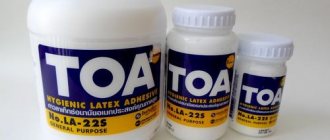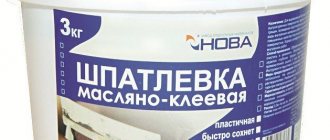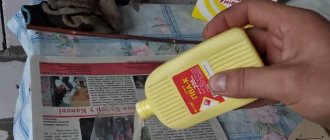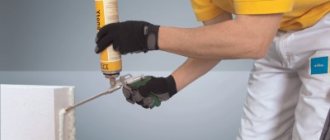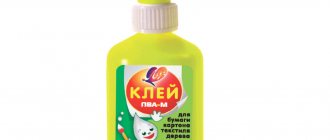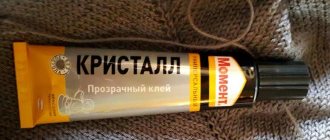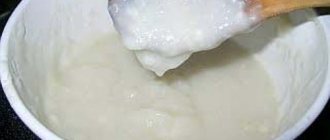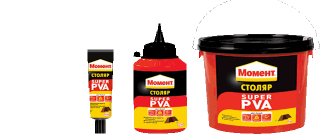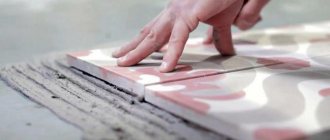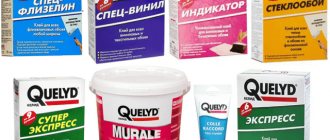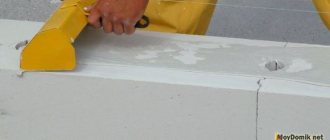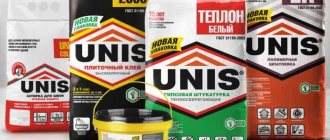Every person has been familiar with PVA glue since school. This composition is used in handicrafts, for office needs, in carpentry, construction and repair. Such a wide range of applications is due to its simple and at the same time unique composition, which ensures certain operational characteristics of the substance.
Description of PVA glue
The abbreviation for the name of the glue stands for polyvinyl acetate. This is a fundamental component of the composition, of which the finished substance contains about 95% of the total volume. This substance is also called polyvinyl acetate glue. This substance was discovered in 1912 by the German doctor F. Klatt, who a little later patented his invention. The first large-scale production was opened in the USA in 1937, and vinyl acetate began to be produced in the vast USSR in the early 1970s. Initially, it was used in the automotive industry.
Today this is one of the most common adhesive compositions, and almost everyone knows that PVA glue is a ready-made, homogeneous, viscous adhesive composition without a pronounced odor, used in various fields of human activity. The main color is light cream, but other shades of white are acceptable in some varieties.
Composition of PVA glue
Each manufacturing plant has its own unique recipe for the composition of what PVA glue consists of:
- It was already mentioned above that the main share is polyvinyl acetate. It can be from 85 to 95% in the composition.
- Water is present, but not in all varieties and can range from 0 to 10% of the total volume.
- Plasticizers are also required to be added to the glue (about 55% of the total volume). This can be EDOS or dibutyl phthalate to give the substance the desired consistency.
- The minimum amount of special additives in the composition is about 0.5%. They enhance certain qualities of the adhesive that are required for use in a particular area. For example, kaolin and chalk increase the strength of the glue, and gasoline or acetone increase moisture resistance.
Waterproof tile adhesive
Using this type of adhesive, floor and wall tiles and mosaics are installed. It is used for both interior and exterior decoration. This type of glue can be used for the following purposes:
- Cement screed.
- Gypsum plaster.
- Ceramic coatings.
- Primed drywall.
- Concrete.
- Sand-cement floor.
Before applying the product, the surface must be thoroughly cleaned, degreased and leveled. Waterproof tile adhesive must meet the following criteria:
- Maintain constant contact with water;
- Withstand temperature changes;
- Withstand chemical exposure;
- Be resistant to mold and mildew;
This glue does not change its structure when exposed to water, does not collapse or erode.
PVA glue - characteristics
To better understand why PVA glue is so popular, its technical characteristics will help:
- The adhesive ability of the composition is high and ranges from 40 to 500 n/m depending on the variety.
- Moisture resistance, which allows it to be used outdoors and in rooms with high humidity - baths, saunas, bathrooms.
- Frost resistance. The composition is able to withstand about 6 cycles of freezing and thawing without losing its original properties.
- The absence of a strong odor and environmental safety, so this glue is used even in kindergartens for creative classes with children.
- Resistant to UV rays.
- Fire and explosion safety. Therefore, glue is used in areas of increased fire danger, laboratories and workshops.
- Low shrinkage and elasticity after drying, which does not disturb the structure of the glued surfaces.
- Economical consumption of about 1 kg per 4-5 sq.m of surface, depending on the thickness of the layer and an affordable price.
Advantages
PVA glue has become widespread due to its many positive properties:
- does not contain chemicals that are harmful to health, so stationery PVA is approved for use by children from 3 years of age;
- does not burn;
- resistant to mechanical stress;
- with increasing internal temperature it becomes more plastic;
- withstands 4-6 freeze-thaw cycles;
- has a neutral odor, which makes it easy to use in enclosed spaces;
- dissolves only from complex compounds of chemicals, but a fresh layer can be easily washed off with water.
What does PVA glue glue?
Many users do not think about the fact that different types of polyvinyl acetate-based adhesives are designed for connecting a wide variety of surfaces:
- Paper and cardboard.
- Vinyl, non-woven, textile and paper wallpaper.
- PVA glue is suitable for wood, fiberboard, chipboard and cork, leather.
- Used to bond porcelain and glass.
- Ceramic tiles for interior work and linoleum.
- The construction variety is added to mixtures for laying street tiles and bricks.
- Present as an additive in some paints, construction mixtures, packaging products and household chemicals.
Classic composition of the product
The vinyl adhesive sold may differ not only from the manufacturer, but also from the final target orientation of the adhesive. If the product is intended for fixing wall materials, then special starch with optimal antifungal properties, universal ether with powerful antibacterial inclusions, as well as polyvinyl acetate type powder can be used as a base. Some manufacturers add a color indicator to the vinyl adhesive, which allows you to control the uniformity of the adhesive application. More expensive formulations boast a pleasant aroma.
Pros and cons of PVA glue
Like any other product of the chemical industry, universal PVA glue has both its advantages and disadvantages. The advantages include:
- No toxic components or pungent odor.
- High adhesive properties and good filling of cracks and gaps.
- Fireproof properties and moisture resistance.
- Affordable cost and economical consumption.
- Possibility of gluing different surfaces.
PVA glue also has its disadvantages:
- The composition cannot be stored in the cold, as it loses its properties when left at low temperatures for a long time.
- In some varieties that do not contain additives that increase resistance to moisture, delamination of the glued parts may occur when water enters.
- If applied to a clean surface, it may leave marks that are difficult to remove once dry.
Purpose of waterproof glue
The basis of waterproof adhesive is adhesive rubber. The wide range of applications of this glue determines its popularity.
With its help, you can glue the material in a cold way; waterproof glue glues the following materials:
- Metal;
- Glass;
- Rubber;
- Concrete;
- Leather;
- Textile;
- Tree;
Waterproof glue can be used to repair shoes, it is also used in the process of creating shoes, the product is also used for gluing building materials, in the process of repairing furniture, textile industry, household purposes and much more.
Types of PVA glue
It was already mentioned above that there are several types of adhesive compositions, differing in their incoming components and scope of application. The most popular types are:
- Household or wallpaper
. This type of compound is suitable for gluing paper and gluing paper-based wallpaper to wood, concrete or plaster surfaces. - Stationery
. This variety is known to many because it is purchased and used more often than others. There is both liquid and PVA pencil glue. Suitable for gluing various types of paper and cardboard. The composition is not waterproof or frost resistant. - Universal
. Suitable for working with wood, paper, cardboard, leather, fabric, glass. It is often added to water-based putties, primers and concrete mixtures. - PVA-M
is characterized by a more heterogeneous watery composition and lower cost. Suitable for working with cardboard, paper and wood. - PVA dispersion, or PVA construction glue
. This is an aqueous solution of a polymer, which serves as the basis for the preparation of other compositions. It is included in construction solutions, compositions for work in glass, printing and other activities, in the production of artistic paints, cigarettes and other things.
Characteristics
Vinyl-based wallpaper adhesive sold today is one of the most reliable adhesives. The product is actively used in repair and finishing work. Vinyl adhesive can be used to work with multiple wall materials. Most often this is wallpaper on paper, bamboo, metal, velor, embossed, fabric, vinyl, or structural basis. Excellent sliding properties allow for maximum quality alignment and joining of the pattern. If the composition has not yet dried, then the master can safely separate the canvas from the surface and glue it again. The final method of application directly depends on the type of wallpaper. If the master has to work with uneven walls and heavy material, then first of all, glue is applied to the base and allowed to soak in. After 20 minutes, you can repeat the action and glue the strip.
How to thicken PVA glue?
In some situations, especially after storing the adhesive for a long time, users find that its consistency has become too thin. If this is not suitable for use, then you can try thickening the waterproof PVA glue yourself. To do this you can:
- Use pure PVA dispersion, which serves as the basis for the glue. However, rarely does anyone have such a chemical in their arsenal at home.
- Gradually add starch (potato or corn) or sifted wheat flour to the mixture. They need to be poured in small portions and mixed thoroughly so as not to get too thick a substance.
How and why to dilute
Polyvinyl acetate glue is often diluted with water. It is not recommended to add water to universal, second and Moment glue, as they will lose their adhesive function. It is also not recommended to dilute dispersion grades. You can dilute household and office glue. This allows you to reduce material consumption or restore its consistency if the glue thickens during storage.
Wallpaper glue is sold dry. Before use, the glue is dissolved in warm water at the rate of 100 grams of dry product per 1 liter of liquid. The solution turns out like thick sour cream so that the brush or roller gets stuck a little in the solution. To obtain a primer, the proportions are slightly changed, increasing the proportion of water.
Office glue is also used as a primer. To dilute it, you will need warm water and adhesive material in a ratio of 2 to 1. The result is a light white liquid product.
Tip: Heavily diluted glue creates a less strong and, therefore, less durable seam.
PVA glue is one of the most versatile compositions; it is used both independently and in combination with additives and modifiers that impart additional beneficial properties. It is still one of the safest adhesive materials available. Use it wisely and the result will meet all your expectations.
How to dilute PVA glue?
The opposite situations also happen when users do not know how to dilute PVA glue when it is thick. If this is an office or household type, then you can:
- Remove the top dried layer.
- Then dilute the PVA glue with clean water at room temperature in a ratio of 10:1 and mix everything thoroughly.
- Leave the composition until all elements are completely mixed for about 30 minutes.
- Solvents, alcohols and acetone cannot be used for these purposes. They can both change the properties of the composition itself and corrode the bonded surfaces.
- Other varieties are not suitable for breeding and must be disposed of or replaced.
Waterproof wood glue
There are several types of waterproof glue and one of them is wood glue. It is made on a polyurethane basis and dries under the influence of air humidity.
Using waterproof wood glue, you can glue any wooden surfaces, all kinds of wood, laminate, MDF, chipboard, fiberboard and plywood products.
It is used for the following work:
- Gluing soft wood parts.
- Gluing hardwood parts.
- Connecting window blocks.
- In the process of laying parquet and laminate flooring.
- For hot and cold presses.
A good waterproof wood glue fills joints tightly, is colorless, and is easy to clean up once dry.
How to glue with PVA glue?
The rules for using PVA glue for wallpaper and other surfaces are simple and consist of the following steps:
- The parts to be glued must be cleaned of dust and debris and thoroughly dried.
- Spot application of glue is possible thanks to a special thin dispenser on the tube. If it is not there, then you can use other convenient items at hand - a syringe, etc.
- PVA glue is applied to large surface areas from the center to the periphery. To do this, use sponges, rollers, and brushes.
- When wallpapering, the composition is applied to the wallpaper itself, and not to the walls.
- When working with wooden surfaces, PVA wood glue is spread on surfaces with less porosity.
- If possible, the products to be glued are held for some time or left under pressure for 2-12 hours if possible.
Disadvantages of the material
Non-woven vinyl adhesive has several negative characteristics that are associated with its improper use. The product is designed to work with massive wallpaper. If the master decides to use vinyl glue for lighter finishing materials, then this is not economically viable. In addition, the prepared mass has a fairly low air permeability. That is why vinyl adhesive is most often used in multifunctional, non-residential premises. But all the advantages of glue significantly outweigh its negative parameters, which is why it is actively used by professionals.
How to quickly dry PVA glue?
Depending on the variety and type of parts being glued, the time it takes for PVA glue to dry varies. It can range from 10-15 minutes. when applied to paper in a thin layer for up to 6-24 hours on wood or fabric. To speed up this process, you can try:
- Before treatment, degrease the surface using alcohol or acetone. The absence of dirt, dust and grease particles will accelerate the adhesion of the substance.
- Provide mechanical pressure on the parts to be glued (put under a press).
- Move surfaces to a dry and warm place. As the temperature gradually increases, the drying time will also decrease.
- In addition, the smaller the layer of PVA glue, the faster it will dry. It is recommended to apply the composition in a thin strip.
Available Applications
The universal composition of vinyl adhesive allows this material to be used for decorative and natural stone, concrete, brick, plaster, as well as porous surfaces. Some types go well with laminate and classic ceramic tiles. Before applying glue, the working surface must be thoroughly cleaned, degreased (with a special product or solvent) and dried. Glue is used not only for finishing various rooms, but also for decorating various interiors with the help of popular decorative elements. The product is effective for attaching various materials to vertical and horizontal surfaces. Vinyl adhesive is suitable for wallpaper and wood surfaces. The transparent, quick-drying composition is effectively used in the manufacture of prefabricated furniture.
How to make PVA glue?
If you need to obtain the adhesive quickly or in large quantities, you can prepare it yourself. To do this you will need:
- 1 liter of distilled water;
- 2.5 g gelatin;
- 2 g liquid glycerin;
- 50 grams of sifted wheat flour;
- 10 ml of ethyl alcohol.
The process of making PVA glue at home is simple, but it is important to know all its nuances to obtain a satisfactory result:
- Gelatin is soaked in a glass of warm water until completely swollen.
- Mix the remaining water with flour in a convenient container. The solution is placed in a water bath.
- Prepared gelatin is added and the mixture is brought almost to a boil over low heat.
- With constant stirring, it is important to achieve the consistency of thick sour cream.
- Afterwards the mixture is removed from the water bath. Ethyl alcohol and glycerin are added to it. After complete cooling, the material is suitable for use.
Papier mache
Using the papier-mâché technique, you can make any Christmas tree decorations, souvenirs, and children's toys. Beginners are recommended to try making papier-mâché in a simple shape, for example, the fairy-tale hero Kolobok.
Have to take:
- newspaper,
- white paper
- small balloon,
- PVA.
First, the balloon must be inflated to the required size. Afterwards, it should be thoroughly lubricated with glue, without leaving dry areas, and 10 layers of torn newspaper should be glued on, regularly coating them with glue. Each layer must dry well before gluing the next one. Then the last layer of scraps of white paper is glued on. After complete drying, the craft needs to be painted and varnished. Instead of a ball, you can take a ball, as well as a toy of a different shape, but to remove it you will have to cut all the layers of the workpiece, and then glue them together and make another paper-adhesive layer.
How to store PVA glue?
Depending on the manufacturer, PVA stationery glue and its other varieties can be stored for 6 months. up to 2 years while maintaining the tightness of the original packaging. Opened glue is generally stored for 3-6 months, after which it loses its properties. However, all these terms are correct only under the correct storage conditions for the composition:
- The air temperature should be within +5…30℃.
- Humidity for liquid substances is no more than 75%, and for dry mixtures for preparation no more than 50%.
- It is better to protect the container from exposure to direct sunlight.
- The original packaging should not be opened unless use is necessary or undesirable under the existing conditions.
Conditions of use and storage
It is important not only to choose the appropriate composition for a specific task, but also to store and apply it correctly in order to obtain a high-quality result.
- Store PVA glue in a dry room at a positive temperature.
- It is important to tightly close the container with glue, otherwise the composition may thicken and dry out.
- The average shelf life of the glue is 6 months from the date of its release. Expired glue thickens, dries over time and loses its properties.
- The finished PVA glue mixture must be used within 20-40 minutes, since after this time it begins to thicken and dry. The exception is stationery glue, which is produced in small quantities. It can be used for six months, closing after each use.
- To ensure the strength of the joint, the surfaces must be degreased before gluing. It is important to remember that the maximum gluing effect is achieved after 24–36 hours.
- Hardened adhesive can be removed with any available solvent, such as gasoline, turpentine, white spirit or ammonia. If the stain is fresh, try wiping it off with a cloth soaked in vodka or vinegar.
- Tools and working glue containers are easily washed with water, and contaminated water is safe for wastewater.
One can only wonder how we ever lived without PVA glue! But even our grandmothers used starch or flour - a paste that had to be boiled. Now PVA glue has become indispensable not only in everyday life, but also in production. Just think: 1 ton of glue can save up to 2 tons of fasteners!
How to clean PVA glue?
Even with the most careful use, no one is immune from accidental contact of glue on clean surfaces. If it is fresh, then only a damp cloth will suffice, which will easily wipe off the adhesive. If the stain is dry, you can pre-treat it:
- medical or ammonia;
- vinegar;
- refined gasoline;
- acetone or white spirit;
- turpentine;
- baking soda.
It is important to remember how to remove PVA glue from clothes. Before pre-treating the stain, it is better to try applying a little of any solvent to an inconspicuous part of the fabric, because it can react with it and ruin the item. If no changes occur, you can use a sponge or brush dipped in soapy water. It is permissible to wash pre-treated items in a washing machine.
Rules for preparing the working solution
To prepare vinyl glue for use, you need to carefully dilute the dry powder with plain water. The proportions must correspond to the attached instructions. The air and water temperature should not be lower than +25 degrees. The powder must be mixed as thoroughly as possible. Only in this case will it be possible to avoid the appearance of lumps. The mixture must be infused for the time specified in the instructions. Before gluing the canvases, be sure to carry out all the necessary preparatory work.
You need to determine a free space on the clean floor. The canvas is leveled on the surface and lubricated with glue. It is best to use a clean, dry cloth to press down the wallpaper. To improve the result, you can go over it with a roller several times. All manipulations must be performed slowly and carefully, as there is always a risk of moving the canvas, which causes wrinkles to form. If the edges of the wallpaper are a little puffy, then they must be additionally lubricated with glue and pressed against the wall. If there are screws or nails on it, it is better to remove them before gluing or drive them deeper. You need to be as careful as possible in the place where sockets and switches are located. To make the result look as neat as possible, you need to cut out the necessary holes with scissors. In order to distribute all efforts as correctly as possible, two people should be involved in the work process. One holds the wallpaper by the top edge, and the other by the bottom. The canvas should go behind the baseboard, which is better to dismantle in advance.
What can be made from PVA glue?
In human activities, the use of PVA glue is very diverse. In everyday life they make it into:
- The so-called adhesive varnish is diluted to the state of milk with warm water. This composition can be used to coat wallpaper and crafts, after which the surface will be matte and protected from mechanical influences.
- Homemade plasticine. To do this, the glue is mixed with food coloring and sodium tetraborate (pharmaceutical antiseptic) until desolate. The finished mass is kneaded in a plastic bag to the desired degree of elasticity.
- Slime is a children's toy that resembles plasticine, only more liquid and viscous. To do this, shaving foam is colored with a dye, to which glue and sodium tetraborate are then added. Everything is thoroughly mixed.
Basic rules for choosing vinyl adhesive
In order for the created decorative finish to please you with its appearance and long service life, you need to take the most responsible approach to choosing the product. The following parameters require increased attention:
- Adhesiveness. This is the degree of adhesion to the main surface, to the main surface. The strength of wallpaper fixation depends on this parameter. It is worth noting that adhesiveness directly depends on the number of shares of polyvinyl acetate for vinyl adhesive.
- Degree of adhesion. It can be primary and final. In the latter case, adhesion is represented, which determines the level of adhesion strength of the canvases to the base after complete drying.
Water resistance classes
Each type of waterproof glue has its own water resistance class, which characterizes its parameters.
- Class D1. This adhesive is used for wood whose moisture content should not exceed fifteen percent.
- Class D2. This adhesive is used for interior work with short-term exposure to moisture and water, which is no more than eighteen percent moisture.
- Class D3. Waterproof adhesive of this class can be used for outdoor work; it can withstand humidity and its fluctuations well in outdoor conditions.
- Class D4. This class of glue can be used for interior and exterior work. It is considered the most resistant to environmental influences.
